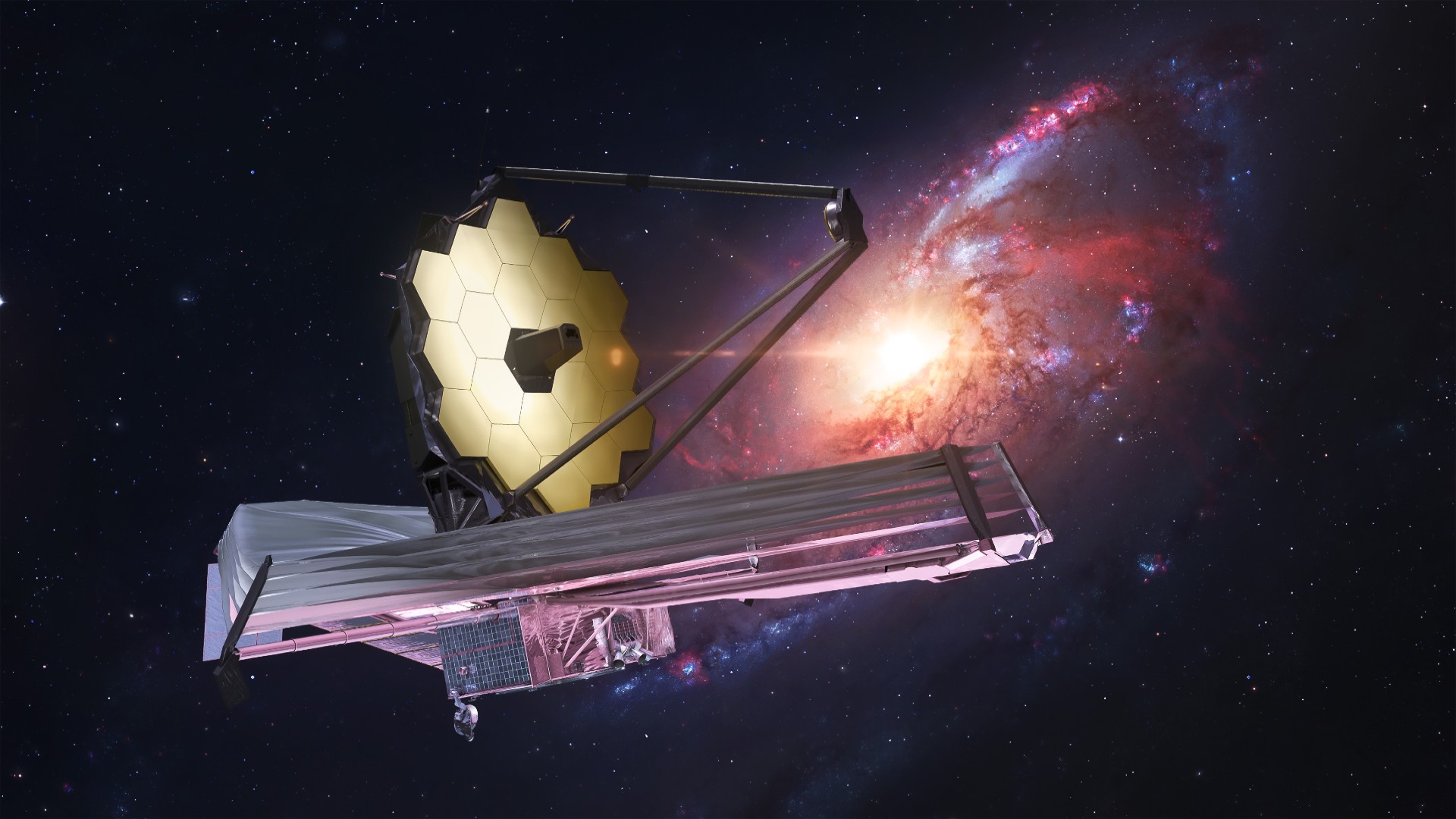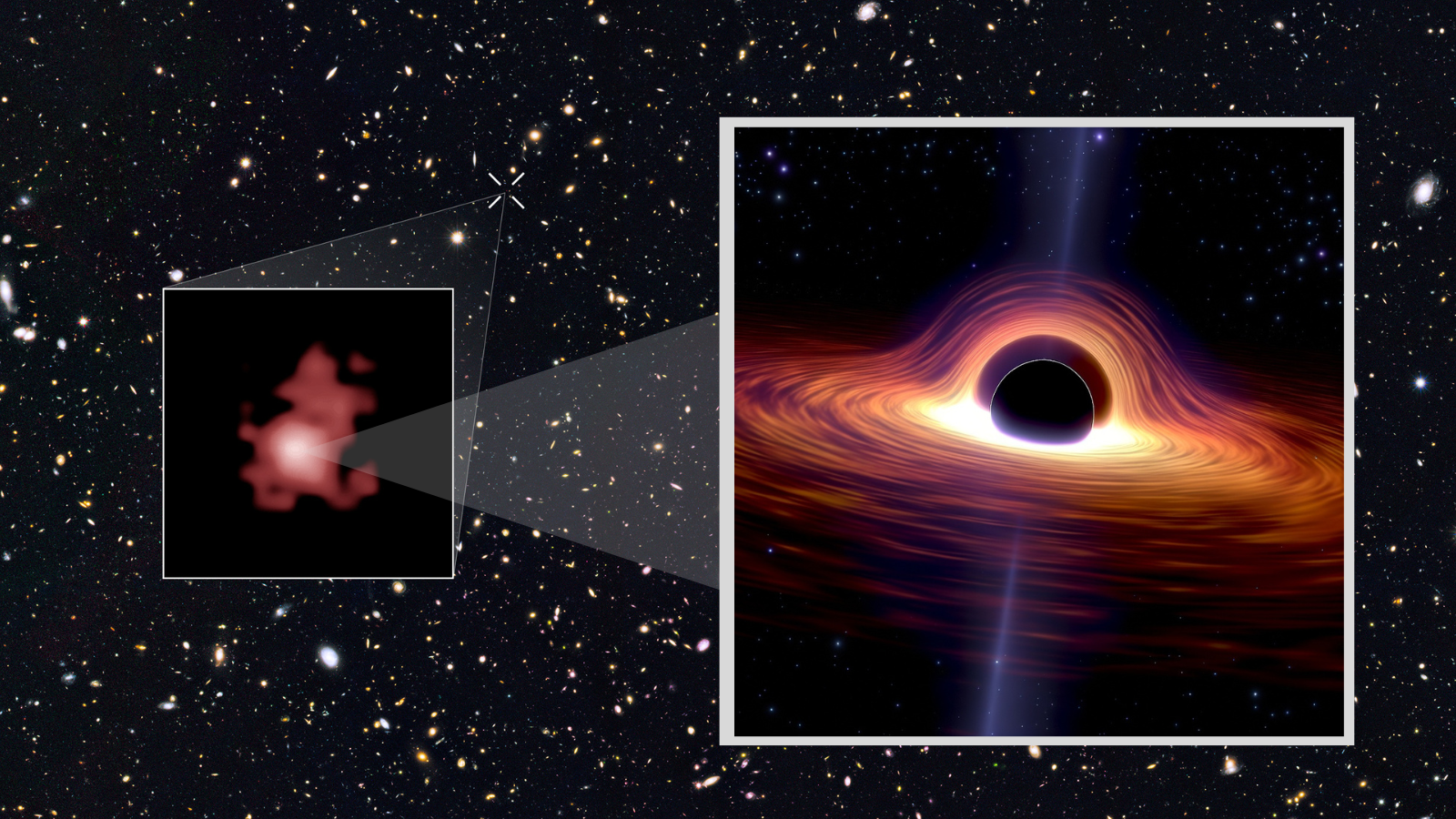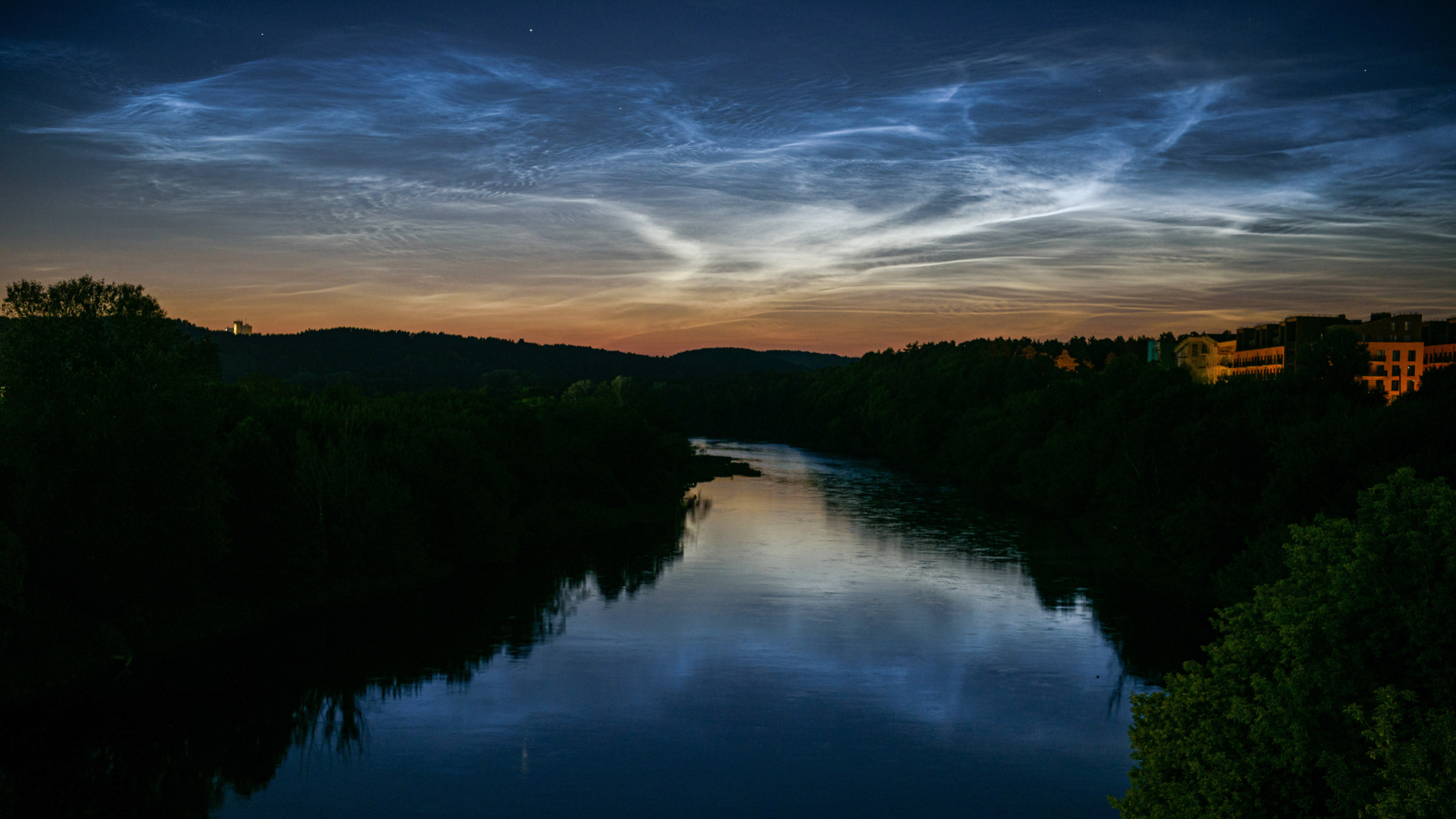'It's extremely worrisome.' NASA's James Webb Space Telescope faces potential 20% budget cut just 4 years after launch
Such a dramatic cut to a flagship space telescope still in its prime will be felt across the mission's entire operations, affecting science.

The scientists behind NASA's largest and most powerful space telescope ever built are bracing for potentially crippling budget cuts, and the observatory is only halfway through its primary mission.
The team overseeing NASA's James Webb Space Telescope (JWST) has been directed to prepare for up to 20% in budget cuts that would touch on every aspect of the flagship observatory's operations, which are managed by the Space Telescope Science Institute (STScI) in Maryland. The potential cut comes even as the space observatory is more in demand than ever before, with astronomers requesting the equivalent of nine years' worth of Webb observing time in one operational year.
"NASA is having budget constraints across the entire board, so the institute is being asked to consider a significant — about 20% — cut to our operational budget for the mission starting later this year," Tom Brown, who leads the Webb mission office at STScI, told a crowd of scientists last month at the 245th American Astronomical Society (AAS) meeting in National Harbor, Maryland. "So the impacts of that, if it comes to pass, pretty much cut across the entire mission."
NASA's $25.4 billion budget request for 2025 set aside $317 million to fund the Webb space telescope, as well as the Hubble Space Telescope and Chandra X-ray Observatory that together comprise NASA's currently operational "Great Observatories." The Hubble Telescope program is facing a potential 20% budget cut of its own, according to SpaceNews. And Chandra is facing the end of its mission, with NASA's 2025 budget request including plans to wind down operations, with its budget dropping from $41.1 million this year to just $5.2 million in 2029.
But unlike Hubble, which turns 35 this spring, and Chandra, which launched in 1999, Webb is in its prime, approaching the midpoint of a primary 10-year mission. It could last at least 20 years or more, NASA officials have said. The mission is an international partnership between NASA, the European Space Agency and the Canadian Space Agency.
"Frankly, this mission works far better than, really, most folks expected it to, you know," Brown said during the Webb town hall event on Jan. 15 at the AAS conference. "It's extremely worrisome that, while we're in the middle of the prime mission, we're also maybe looking at significant budget cuts."

The $10 billion Webb space telescope survived a tumultuous development process, one that included cost overruns and technical delays that nearly killed the observatory before it ever flew. Lawmakers with the House Appropriations Committee proposed cancelling the mission in 2011, a decade before Webb's Christmas Day launch in 2021, only to back down after backlash from scientists and influential politicians defending the observatory.
Get the Space.com Newsletter
Breaking space news, the latest updates on rocket launches, skywatching events and more!
Since its 2021 launch, the Webb space telescope has outmatched even the most optimistic predictions for its performance. Its infrared optics have looked deep into the universe's past, observed distant galaxies and exoplanets, and even peered at our own local solar system planets closer to home.
"In a nutshell, it is truly fulfilling its promise," Macarena Garcia Marin, STScI's Webb project scientist, said during the same town hall event. "Across every field, JWST is truly delivering cutting-edge science."
Some of Webb's budget challenges stem from its operational costs, which were set "idealistically low" in 2011 when the observatory was saved from cancellation. Those costs, coupled with inflation rates that were much higher than expected and less flexibility in NASA's budget, have also contributed, Brown said.
According to a presentation by Brown, a 20% cut to Webb's operational budget would definitely affect how much science the telescope could perform. The impacts would be felt across teams that review proposals for observing targets, data analysis, observatory efficiencies, and anomaly resolution when something goes wrong, not to mention the need to engage with the scientific community and public on Webb's science results.
"It's a huge cut. That's not like kind of trying to nibble away at the edges," Brown told Space.com. "That impacts everything across the board, all the way up to how many modes we're offering to the observers."
Those impacts, Brown said, would likely be felt for the first time in October, when the next fiscal year begins.
Brown's comments at the Webb observatory town hall at AAS came just before the inauguration of President Donald Trump, who in subsequent weeks created the Department of Government Efficiency headed by SpaceX CEO Elon Musk to reduce government spending. DOGE, as it's known, has worked to dismantle some entire agencies, like the U.S. Agency for International Development, which provides aid to other countries during disasters and other emergencies, while also overseeing massive cuts to the federal workforce. Nearly 1,000 NASA jobs could be eliminated, though they appear to have been saved from layoffs earlier this week.
Trump has nominated American billionaire entrepreneur Jared Isaacman, who has flown in orbit twice on private SpaceX missions he financed himself, to serve as the next NASA administrator, though Isaacman has yet to be confirmed. The agency is currently being led by Acting Administrator Janet Petro, former director of the agency's Kennedy Space Center in Florida.
Join our Space Forums to keep talking space on the latest missions, night sky and more! And if you have a news tip, correction or comment, let us know at: community@space.com.

Tariq is the Editor-in-Chief of Space.com and joined the team in 2001, first as an intern and staff writer, and later as an editor. He covers human spaceflight, exploration and space science, as well as skywatching and entertainment. He became Space.com's Managing Editor in 2009 and Editor-in-Chief in 2019. Before joining Space.com, Tariq was a staff reporter for The Los Angeles Times covering education and city beats in La Habra, Fullerton and Huntington Beach. In October 2022, Tariq received the Harry Kolcum Award for excellence in space reporting from the National Space Club Florida Committee. He is also an Eagle Scout (yes, he has the Space Exploration merit badge) and went to Space Camp four times as a kid and a fifth time as an adult. He has journalism degrees from the University of Southern California and New York University. You can find Tariq at Space.com and as the co-host to the This Week In Space podcast with space historian Rod Pyle on the TWiT network. To see his latest project, you can follow Tariq on Twitter @tariqjmalik.
-
Moonwatcher Considering that the JWST was 10X overbudget and likely should have been cancelled, astronomers should be looking at the glass as being 80% full, not 20% empty. Any data we get from JWST is lucky gravy at this point. In the future, hopefully NASA will do a better job at staying on time and on budget - like they used to do. All research will depend on that. And given new launch assets coming online in the near future allowing larger payloads, telescopes even more capable than the JWST can be fielded without being so complex and costly.Reply -
LemmyCaution Reply
In view of NASA having sunk 24 billion dollars into the development of the Space Launch System and has effectively nothing to show for that huge expenditure one might argue the James Webb Telescope is in comparison a resounding success story and as such a relative bargain to boot.Admin said:Such a dramatic cut to a flagship space telescope still in its prime will be felt across the mission's entire operations, affecting science.
It's extremely worrisome.' NASA's James Webb Space Telescope faces potential 20% budget cut just 4 years after launch : Read more -
Startseq I would love to see the budget to look at how the $317m is to be spent. Something tells me that with an annual "lottery win" of that much money there are lots of funds directed away from the real expenses for the observatories! Something also tells me that if the funds are spent honestly, the 80% is more than enough to fully extract all the science out of the telescopes. Maybe DOGE looked at the budget??Reply -
Unclear Engineer Reply
What makes you think that DOGE has actually looked at the details of the budget? If they had, and had actually found wasteful spending, I am sure we would hear about it.Startseq said:I would love to see the budget to look at how the $317m is to be spent. Something tells me that with an annual "lottery win" of that much money there are lots of funds directed away from the real expenses for the observatories! Something also tells me that if the funds are spent honestly, the 80% is more than enough to fully extract all the science out of the telescopes. Maybe DOGE looked at the budget??
So far, DOGE has only acquired agency data, and various parts of the administration have forced percentage cuts without actually knowing what they are cutting (except "DEI").
Having actually worked in a Federal agency, I can tell you that there is waste, and I can tell you that dismissing all of the probationary employees and urging others to resign is the worst way to trim agencies - it removes the real workers while leaving the "fat" in place. The ones who are willing to leave are the ones who are good enough to get other jobs outside the government, while the probationary employees are the ones who, despite limitations on hiring, are approved and selected to fill gaps in the workforce that need to be addressed to fulfil the agencies mission. The way this is being done, waste will increase, and the effectiveness will decrease - worst possible choice. -
Startseq Reply
I'm sure they're doing it all wrong, but there have been many administrations and personnel over the past years that knew how to do it correctly, but didn't. Time to put out the fire and regroup.Unclear Engineer said:What makes you think that DOGE has actually looked at the details of the budget? If they had, and had actually found wasteful spending, I am sure we would hear about it.
So far, DOGE has only acquired agency data, and various parts of the administration have forced percentage cuts without actually knowing what they are cutting (except "DEI").
Having actually worked in a Federal agency, I can tell you that there is waste, and I can tell you that dismissing all of the probationary employees and urging others to resign is the worst way to trim agencies - it removes the real workers while leaving the "fat" in place. The ones who are willing to leave are the ones who are good enough to get other jobs outside the government, while the probationary employees are the ones who, despite limitations on hiring, are approved and selected to fill gaps in the workforce that need to be addressed to fulfil the agencies mission. The way this is being done, waste will increase, and the effectiveness will decrease - worst possible choice. -
Unclear Engineer Reply
Well, that opinion is completely illogical.Startseq said:I'm sure they're doing it all wrong, but there have been many administrations and personnel over the past years that knew how to do it correctly, but didn't. Time to put out the fire and regroup.
Doing it wrong and making things worse isn't justified because others did not do it right.
It is DOGE's responsibility to do it right. They are supposed to cut "waste, fraud and abuse", not leave the waste fraud and abuse in-place and cut agencies' abilities to actually do their legislated missions. -
Moonwatcher Reply
SLS was never about getting back to the moon. It was just a jobs program to keep people in jobs in powerful Senators' and Congressmen's states. If it had been about going back to the moon, we would have built SLS as Block 2 from the get-go and never done these anemic payload versions at such exorbitant costs. And if NASA had actual project managers who knew what they were doing we wouldn't have allowed a mobile launch tower for SLS to balloon from $250 million to over $2 BILLION - and it still isn't finished.LemmyCaution said:In view of NASA having sunk 24 billion dollars into the development of the Space Launch System and has effectively nothing to show for that huge expenditure one might argue the James Webb Telescope is in comparison a resounding success story and as such a relative bargain to boot. -
Classical Motion I was drafted when I was a kid. My first experience with a gov agency. Excluding the DMV.Reply
Later I worked for a company whose bread and butter was several gov agencies. Very nice bread and butter.
One should be able to trim 20% from any gov agency. Without loss of time or service.
Just a personal observation. -
losgatos_dale An honest examination of the requested budget will show you that Webb is NOT facing a 20% cut to actual operating expenses. For example, funding extensive grant programs for graduate degrees. Whether you think that is part of NASA's mission or not it is certainly NOT "operating expense." Perhaps its more debateable that NASA should also be paying the science community to do it's science?Reply
Try this: using a round estimate of 1/4 million dollars per year for an FTE can show how bloated the STSci request really is. It breaks my heart that unfettered spending can put so much at risk, and that otherwise lucid individuals can overlook attempting to fund the equivalent of 750 FTEs on the ledger of one operational gov't paid science mission. If the 2011 estimates for mission ops were woefully underestimated, then what would YOU call requesting the equivalent of 750 full time employee's salaries for mission ops?
